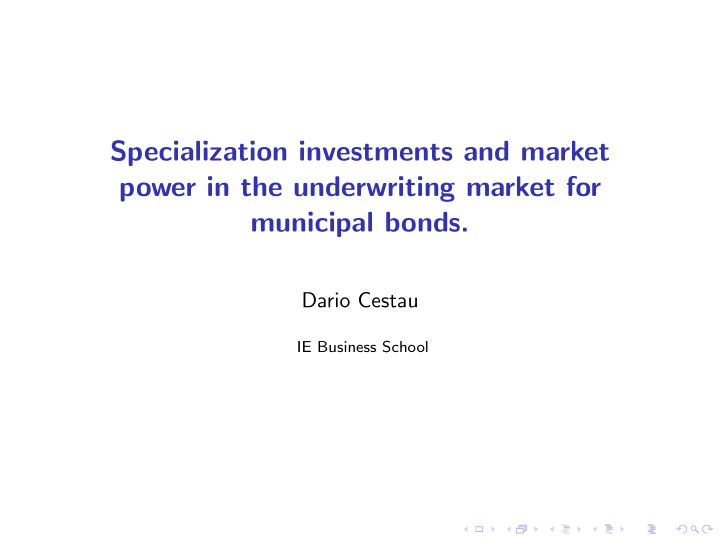



Specialization investments and market power in the underwriting market for municipal bonds. Dario Cestau IE Business School
Heat map top 7-12 underwriters of school bonds Actual Theoretical
Why are underwriters segmented by state? ◮ Part 1: ◮ Question 1: Strong entry barriers. What are these barriers? ◮ Finding 1: Underwriters specialize either in competitive sales or negotiated sales in each state. ◮ Conclusion 1: They have different entry barriers. ◮ Part 2: ◮ Question 2: What are entry barriers for each sale type? ◮ Finding 2: Top negotiated underwriters tend to be local, and top competitive tend to be national banks based in NYC. ◮ Conclusion 2: Underwriting firms with pre-established broker-dealer relationships have an advantage in competitive sales. Local firms can provide more non-yield benefits, giving them an advantage in negotiated sales.
Sample ◮ Issuers: independent school districts. ◮ Simple and homogenous across states. ◮ School bonds constitute a large sample. ◮ ISDs generally issue simple plain vanilla bonds. ◮ They can’t self-regulate. ◮ 63,389 deals in 36 states between 1990 and 2014. ◮ Periods: 5 periods of 5 years each: 150 state-periods. ◮ For each state-period, I measure the market shares of the top 3 competitive and the top 3 negotiated underwriters.
Pennsylvania 2000-04 - Market shares Negotiated Competitive Dain Rauscher: 18% Boenning: 33% Arthurs Les: 17% PNC: 11% BNY-Mellon: 19% Paine Webber: 10% BNY-Mellon: 4.6% Dain Rauscher: 0% Paine Webber: 0.9% Arthurs Les: 0% Boenning: 0.5% PNC: 0%
Pennsylvania 2000-04 - Drop market shares Negotiated Competitive Dain Rauscher: 18% Boenning: 33% Arthurs Les: 17% PNC: 11% BNY-Mellon: 19% Paine Webber: 10% BNY-Mellon: 4.6% Dain Rauscher: 0% Paine Webber: 0.9% Arthurs Les: 0% Boenning: 0.5% PNC: 0%
Median drops in market shares ◮ All bonds: ◮ Top negotiated: 72% in deals, 85% in notional amount. ◮ Top competitive: 69% in deals, 94% in notional amount. ◮ New-money unlimited vanilla example: ◮ Negotiated: 84% in deals, 95% in amount. ◮ Competitive: 88% in deals, 100% in amount. ◮ Ranking regression: rknCOMP i , s = a + b ∗ rknNEG i , s + ε ◮ High negotiated rankings lead to lower competitive rankings. ◮ Substantial ranking reversion. ◮ Not a spurious result : they genuinely specialize.
Types of underwriters ◮ I classify each top underwriter in each state-period according to the location of the HQ relative to the state: ◮ Local-N : local and never a top underwriter in another state. ◮ Local-X : local and also a top underwriter in other states. ◮ Regional-1 : HQ in a contiguous state. ◮ Regional-2 : HQ at two state borders. ◮ National : None of the above. Underwriter type by sale method specialization Nat Reg-2 Reg-1 Loc-X Loc-N Top 3 Neg 22% 12% 20% 19% 27% Top 3 Comp 55% 5% 17% 15% 8%
Conclusion Postulation: ◮ Underwriting firms with pre-established broker-dealer relationships have an advantage in competitive sales. ◮ Local firms can provide more non-yield benefits, giving them an advantage in negotiated sales. ◮ Not know-how. ◮ Not reputation (in the case of competitive sales). Sales laws: ◮ Cestau et al.(2018): bans on private sales save 13bp per deal. ◮ 15 states have relaxed the bans of on negotiated sales. Why? ◮ To favor local firms. ◮ Local firms make a stronger lobby group.
Recommend
More recommend